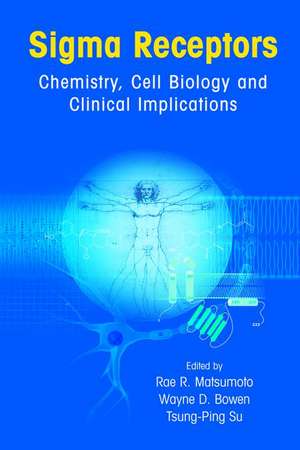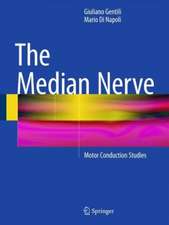Sigma Receptors: Chemistry, Cell Biology and Clinical Implications
Editat de Rae R. Matsumoto, Wayne D. Bowen, Tsung Ping Suen Limba Engleză Hardback – 2 noi 2006
| Toate formatele și edițiile | Preț | Express |
|---|---|---|
| Paperback (1) | 1222.94 lei 43-57 zile | |
| Springer Us – 15 noi 2014 | 1222.94 lei 43-57 zile | |
| Hardback (1) | 1230.84 lei 43-57 zile | |
| Springer Us – 2 noi 2006 | 1230.84 lei 43-57 zile |
Preț: 1230.84 lei
Preț vechi: 1501.03 lei
-18% Nou
Puncte Express: 1846
Preț estimativ în valută:
235.52€ • 246.53$ • 196.03£
235.52€ • 246.53$ • 196.03£
Carte tipărită la comandă
Livrare economică 31 martie-14 aprilie
Preluare comenzi: 021 569.72.76
Specificații
ISBN-13: 9780387365121
ISBN-10: 0387365125
Pagini: 413
Ilustrații: X, 413 p.
Dimensiuni: 155 x 235 x 28 mm
Greutate: 0.82 kg
Ediția:2007
Editura: Springer Us
Colecția Springer
Locul publicării:New York, NY, United States
ISBN-10: 0387365125
Pagini: 413
Ilustrații: X, 413 p.
Dimensiuni: 155 x 235 x 28 mm
Greutate: 0.82 kg
Ediția:2007
Editura: Springer Us
Colecția Springer
Locul publicării:New York, NY, United States
Public țintă
ResearchDescriere
Over the last 30 years, our understanding of a receptors has undergone a colossal evolution. They began as theoretical entities, then progressed to enigmatic receptors, and finally to identified proteins with important biological functions. Since the first book on a receptors was published in 1994, there have been many significant advances in the field. We now know that o receptors subserve many critical functions in the body and recent studies indicate that they are promising drug development targets for a host of neurological, psychiatric, cardiovascular, ophthalmological, immunological, and gastrointestinal disorders. This book provides a timely update on the medicinal chemistry, cell biology, and clinical implications of a receptors. It puts the information in a historical perspective to help new comers to the field successfully navigate the confusing early history surrounding these proteins, and it provides a launching point from which future studies and research directions can easily be developed. The full impact of a receptors on biological function has yet to be determined. The existing gaps in our knowledge base offer untold opportunities for future research. It is our hope that the information contained in this book will stimulate new, exciting research on a receptors and ultimately lead to innovative insights into basic biological mechanisms and novel therapeutic advances.
Cuprins
Contributing Authors.- Preface.- s Receptors: Historical Perspective and Background.- Medicinal Chemistry: New Chemical Classes and Subtype Selective Ligands.- Irreversible s Compounds.- Pharmacophore Models for s1 Receptor Binding.- Cloning of s1 Receptor and Structural Analysis of its Gene and Promoter Region.- Site-Directed Mutagenesis.- s Receptor Modulation of Ion Channels.- Subcellular Localization and Intracellular Dynamics of s1 Receptors.- Intracellular Signaling and Synaptic Plasticity.- Modulation of Classical Neurotransmitter Systems by s Receptors.- s2 Receptors: Regulation of Cell Growth and Implications for Cancer Diagnosis and Therapeutics.- Cognitive Effects of s Receptor Ligands.- s Receptors and Schizophrenia.- Potential Role of s1 Ligands and Neurosteroids in Major Depression.- s Receptors and Drug Abuse.- s1 Receptors and Modulation of Opiate Analgesics.- s Receptors in the Immune System: Implications for Potential Therapeutic Intervention - an Overview.- s Receptors and Gastrointestinal Function.- Appendix.
Textul de pe ultima copertă
Sigma receptors are promising drug development targets for a host of neurological, psychiatric, oncological, immunological, cardiovascular, ophthalmological, and gastrointestinal disorders. They are structurally unique proteins that are distinct from classical G protein-coupled receptors, ionotropic receptors, or receptor tyrosine kinases. With two subtypes currently known, they modulate cell survival and excitability, and subserve many critical functions in the body. Endogenous ligands for these receptors are unknown, though current clues point to neurosteroids.
This book provides a timely update on the medicinal chemistry, cell biology, and clinical implications of sigma receptors. It puts the information in a historical perspective to help new comers to the field successfully navigate the confusing early history surrounding these proteins, and provides a launching point for the development of exciting, new research.
Sigma Receptors: Chemistry, Cell Biology and Clinical Implications will be a valuable tool for pharmacologists, medicinal chemists, cell biologists, molecular biologists, clinicians, and others interested in a concise, state-of-the-art overview of the sigma receptor field with a particular view towards novel therapeutic advances.
This book provides a timely update on the medicinal chemistry, cell biology, and clinical implications of sigma receptors. It puts the information in a historical perspective to help new comers to the field successfully navigate the confusing early history surrounding these proteins, and provides a launching point for the development of exciting, new research.
Sigma Receptors: Chemistry, Cell Biology and Clinical Implications will be a valuable tool for pharmacologists, medicinal chemists, cell biologists, molecular biologists, clinicians, and others interested in a concise, state-of-the-art overview of the sigma receptor field with a particular view towards novel therapeutic advances.
Caracteristici
Provides a valuable resource for those who work on sigma receptors and also as a source of comparative information for researchers on opioid and other receptors
Includes supplementary material: sn.pub/extras
Includes supplementary material: sn.pub/extras

















